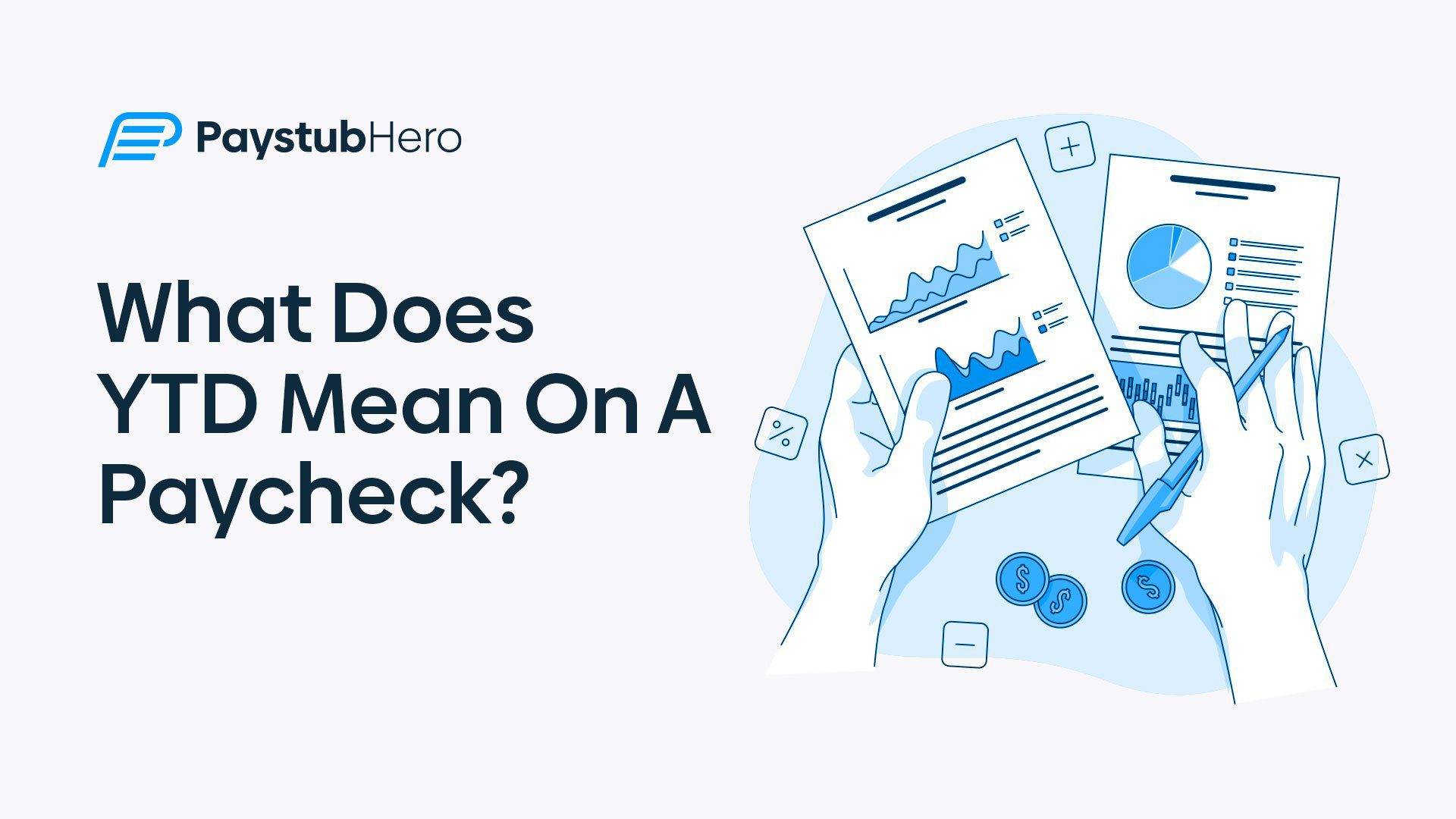If you’ve ever looked at your paycheck and found yourself puzzling over the various terms and abbreviations listed, you’re not alone. Paychecks can be complicated, packed with financial jargon that can leave even the most seasoned employee scratching their head.
Among the most commonly misunderstood terms is “YTD,” an abbreviation that pops up frequently on paychecks and other financial documents. So, what does YTD mean on a paycheck?
YTD stands for “Year to Date.” At its core, this term represents the total earnings you’ve accumulated from the start of the calendar year up to the current date of the paycheck.
Whether you’re an employee wanting to understand your income or an employer seeking to offer transparency to your team, understanding the concept of YTD is crucial.
But it’s not just about the raw definition. It’s also about comprehending the implications of YTD for your financial management and tax planning, and the role it plays in your overall financial health. In this article, we’ll provide a detailed exploration of YTD—what it means, why it’s important, and how it can influence your financial decisions.
We’ll also delve into related terms such as gross pay and explore tools like the YTD calculator to give you a comprehensive understanding of this essential financial concept.
Armed with this knowledge, you’ll be in a stronger position to manage your money effectively, make more informed financial decisions, and perhaps even enhance your earning potential. So, let’s embark on this journey to financial enlightenment together.
Absolutely, I’d be glad to create a table of contents for this article. Here it is:
Table of Contents
- Introduction: Answering the Question, “What does YTD mean on a paycheck?”
- Understanding YTD: A Comprehensive Breakdown
- Year to Date Meaning in the Payroll Context: The Full Picture
- Understanding Gross Pay: A Pillar of YTD Calculations
- The Significance of YTD Calculator in Personal Finance: Why It Matters
- Demystifying the Phrase: “What Does YTD Stand for?” – A Deep Dive
- An Actionable Step: Making Use of Your YTD Information
- Paystubhero: Your Trusted Partner for Streamlined Payroll Management
Understanding YTD: A Comprehensive Breakdown
Understanding YTD, or Year to Date, is a crucial part of gaining comprehensive financial literacy. On the surface, YTD refers to the period starting from the first day of the current year, whether it’s a calendar or fiscal year, and ending on the current day.
While this might seem straightforward, the real value of YTD becomes apparent when you dig a little deeper.
In a broader sense, YTD encapsulates more than just a time frame. It provides a snapshot of your financial journey over the course of the year. When you see the YTD figure on your paycheck, it’s not just a random number.
It’s a record of your accumulated earnings, inclusive of salaries, bonuses, commissions, and overtime, up to the current date.
But it’s more than just about earnings. The YTD figure also details the total amount of taxes withheld from your paycheck, the sum of your retirement contributions, and other deductions over the course of the year.
This vital information offers insights into your income trends, spending patterns, and tax liabilities.
Moreover, understanding YTD can help you track your financial goals. Are you saving enough for your retirement?
Are your tax withholdings accurate? Do you need to adjust your budget for the rest of the year? By knowing your YTD, you’re not just looking at numbers—you’re looking at your financial story unfolding over the year, giving you the tools to script it better.
As we delve further into this topic, we will explore more intricate details related to YTD, including its relevance in payroll context, the meaning of gross pay in YTD calculations, the role of YTD calculators, and how to take actionable steps using your YTD information.
Keep reading to gain a comprehensive understanding of this fundamental financial concept.
Year to Date Meaning in the Payroll Context: The Full Picture
In the realm of payroll, the Year to Date meaning takes on an added dimension of significance.
Here, it’s not just a time-bound concept. Instead, it reveals an ongoing, cumulative picture of an employee’s earnings and deductions throughout the fiscal or calendar year.
At the most basic level, YTD in a payroll context denotes the total gross pay an employee has earned since the start of the year.
This gross pay is a comprehensive sum, encompassing all income types—base salary, overtime payments, bonuses, and any other additional remuneration—before any deductions.
However, the implications of YTD go far beyond a single number on your paycheck. It helps illuminate your earnings pattern, providing valuable insights that can influence several key aspects of your financial life.
For instance, understanding your YTD earnings can help you budget more accurately, plan for taxes, manage debts, and even make informed decisions about major purchases like a house or a car.
Moreover, employers also find YTD valuable. From their perspective, YTD figures help in maintaining accurate records of employee compensation, calculating taxes, and ensuring regulatory compliance.
Additionally, they serve as an essential tool for workforce budgeting and planning.
As we move forward, we’ll examine the crucial relationship between gross pay and YTD, the role of a YTD calculator in personal finance, and the practical implications of understanding what YTD stands for.
With this understanding, you’ll be better equipped to navigate the complexities of payroll, ultimately leading to more informed financial decisions.
Understanding Gross Pay: A Pillar of YTD Calculations
Before we can fully comprehend the complexities of YTD calculations, it’s vital that we first understand the concept of gross pay. Gross pay is a central pillar of YTD calculations, forming the basis upon which all other computations are made.
So, what does gross pay mean? In essence, gross pay represents the total compensation received by an employee before any deductions are made.
This includes your base salary, as well as any additional financial rewards you may receive, such as overtime, bonuses, commissions, and other types of compensation related to your job.
Understanding your gross pay’s role within YTD calculations is crucial to comprehending your overall earnings and potential tax liabilities. The gross pay forms the foundation upon which YTD calculations are made.
Your YTD figure on your paycheck represents the accumulated gross pay you’ve earned from the start of the year up until the present. It provides a cumulative, running total of all the gross pay you’ve earned within the given year.
But the importance of understanding gross pay extends beyond merely calculating your YTD earnings. It’s an essential figure that influences many facets of your financial life. For instance, gross pay is a key factor when it comes to calculating income tax, determining retirement contributions, and even assessing your eligibility for certain benefits.
Moreover, lenders often consider your gross pay when deciding whether to approve your application for a loan or credit.
As we delve further into this article, we will cover more vital aspects of YTD, such as the role of a YTD calculator in personal finance and what YTD stands for in the broader financial landscape.
With this knowledge in hand, you will be in a stronger position to manage your financial affairs effectively.
The Significance of YTD Calculator in Personal Finance: Why It Matters
In the vast universe of personal finance, various tools can help you navigate your journey. Among these, a YTD calculator holds a place of significance. Why, you might ask?
Let’s delve into the reasons behind this and unravel the role it plays in your financial life.
A YTD calculator, as the name implies, is a tool that enables you to calculate your Year to Date gross income.
At first glance, this might seem like a simple arithmetic exercise, but the implications of this calculation are wide-ranging and impactful.
The benefits of using a YTD calculator extend into multiple facets of personal finance. It serves as a guiding star, helping you stay on track with your financial goals throughout the year.
For instance, by knowing your YTD income, you can assess if you’re on track to meet your annual financial goals and make necessary adjustments if you’re not.
Beyond goal-setting and budgeting, a YTD calculator can also aid in debt management. Knowing your YTD income can give you a clearer picture of your ability to meet existing debt obligations or handle new ones.
Another crucial aspect is the role a YTD calculator plays when it comes to loans and credit. Lenders often require details of your YTD income when you apply for loans or credit. It helps them assess your ability to repay, thus influencing their decision to approve your application.
Lastly, a YTD calculator is a potent tool for tax planning. By providing an accurate figure of your gross income for the year, it allows you to estimate your tax liabilities and plan accordingly, thus preventing any unpleasant surprises during tax season.
As we continue to explore the concept of YTD and its relevance in the financial world, we’ll also shed light on the implications of understanding what YTD stands for.
Remember, knowledge is power, and the more you understand these terms and tools, the better equipped you will be to make sound financial decisions.
Demystifying the Phrase: “What Does YTD Stand for?” – A Deep Dive
One of the common phrases we often come across in our financial journey is “YTD.”
Whether it’s in our paychecks, financial reports, or stock market analysis, this term appears quite frequently. But what does YTD stand for, and why is it so essential in the financial and payroll landscape?
As we’ve mentioned, YTD stands for Year to Date. On its surface, it’s a simple acronym that indicates a specific timeframe from the start of the current year up to the present day.
However, this abbreviation holds a significant amount of weight in various financial contexts.
In the payroll and personal finance realm, YTD acts as a comprehensive record of your earnings and deductions throughout the year. It’s like a financial diary that tells the story of your earnings, tax withholdings, and other payroll deductions from January 1st to the current date.
This ongoing tally of your financial transactions is more than just a useful reference—it’s a critical tool for financial planning, budgeting, and tax management.
Meanwhile, in the world of investments and corporate finance, YTD serves as a standard measure of performance. It’s used to track changes in stock prices, investment portfolios, or a company’s financial performance from the start of the calendar or fiscal year.
This information can be invaluable for investors and business leaders, aiding them in making informed decisions.
Furthermore, the concept of YTD also holds value for lenders and creditors. Knowing an individual’s or business’s YTD income helps assess creditworthiness and repayment capacities, thus informing lending decisions.
So, while “what does YTD stand for?” might seem like a straightforward question, the answer’s implications are far-reaching.
As we move forward, we’ll discuss how to use this understanding of YTD to take actionable steps in managing your finances. Knowledge of these concepts can empower you, leading to better financial decisions and healthier financial habits.
An Actionable Step: Making Use of Your YTD Information
Now that we’ve demystified what YTD stands for and its meaning in various financial contexts, let’s move to the next crucial step—utilizing this knowledge. Understanding YTD and related concepts is half the battle; the other half is knowing how to put that understanding into action to better manage your financial affairs.
Having an accurate YTD figure at your disposal provides a comprehensive view of your financial status and progress over the year. You can leverage this information for a variety of purposes, each contributing to a more informed financial decision-making process.
Firstly, YTD figures are an excellent resource for budgeting. By knowing your total earnings and expenses to date, you can assess whether your current spending habits align with your financial goals.
If you find discrepancies, you can make necessary adjustments to keep your financial plans on track.
Secondly, your YTD information can assist you in effective tax planning. With an accurate estimate of your yearly income, you can estimate your tax liabilities for the year.
This knowledge can help you set aside sufficient funds for tax payments, thus avoiding potential penalties or late fees.
Thirdly, your YTD figures can prove invaluable when it comes to making significant financial decisions, such as taking out a loan or making a large purchase.
Lenders and sellers often require information about your YTD income to assess your ability to meet financial obligations. Providing accurate YTD information can improve your chances of securing favorable terms.
Finally, using a YTD calculator to keep track of your YTD earnings and deductions can save you considerable time and effort. This tool can provide an accurate and up-to-date snapshot of your financial health, enabling you to make adjustments as needed quickly.
Understanding the meaning of YTD and its implications is indeed valuable, but the real power lies in using that understanding to make informed decisions and take control of your financial destiny.
Remember, every step you take toward understanding and managing your financial life is a step towards financial freedom. Stay curious, stay informed, and most importantly, stay empowered.
Paystubhero: Your Trusted Partner for Streamlined Payroll Management
If you’re a freelancer, small business owner, entrepreneur, or independent contractor, managing your payroll can seem like a daunting task. Traditional payroll software providers often cater to larger businesses, leaving you with complex systems that aren’t tailored to your needs.
This is where Paystubhero comes into the picture, bringing you a simple, efficient, and affordable solution for all your payroll needs.
Paystubhero is an online payroll software specifically designed with you in mind. We understand that as a solopreneur or small business owner, you need a solution that’s easy to use, reliable, and doesn’t break the bank.
Our software is just that—a robust, simplified solution that makes generating essential payroll documents as easy as 1-2-3.
But our commitment to you goes beyond simplifying payroll management. We also want to empower you to understand and control your financials better. Our platform not only calculates your earnings, deductions, and YTD totals but also helps you comprehend what these figures mean.
You can use our platform to gain insights into your income patterns, track your YTD earnings, and plan for your tax obligations.
Moreover, Paystubhero ensures accuracy in all your calculations. By providing a streamlined, automated process, we eliminate the possibility of human errors that could lead to costly mistakes.
All you need to do is enter your company and employee information, and our software handles the rest—accurate calculations, comprehensive records, and ready-to-print paystubs at your fingertips.
With Paystubhero, you’re not just getting a software—you’re getting a trusted partner committed to helping you manage your finances more effectively. We stand by your side, ensuring that you’re equipped with the tools, knowledge, and support you need to thrive in your financial journey.
If you’re ready to simplify your payroll management and gain greater control over your finances, it’s time to try Paystubhero.
Don’t let the complexities of payroll management hold you back. Let Paystubhero be your guide, and together, we can empower you to reach your financial goals.
Frequent Asked Questions
- What does YTD mean on pay statements?
- YTD, or Year to Date, on pay statements refers to the total earnings, deductions, or hours from the beginning of the calendar year to the present date. It provides a running total of your financial transactions throughout the year.
- What is an example of YTD?
- If your monthly salary is $4000, and it’s currently the end of April, your YTD earnings would be $16,000 ($4000/month * 4 months).
- What do the abbreviations on my paystub mean?
- Paystub abbreviations generally represent various payroll factors. For example, “YTD” stands for Year to Date, “Gross” refers to total earnings before deductions, and “Net” means the amount left after deductions.
- What is the difference between YTD and gross pay?
- Gross pay refers to your total earnings before deductions for a specific pay period, while YTD is the cumulative total of your gross pay from the start of the year to the present date.





